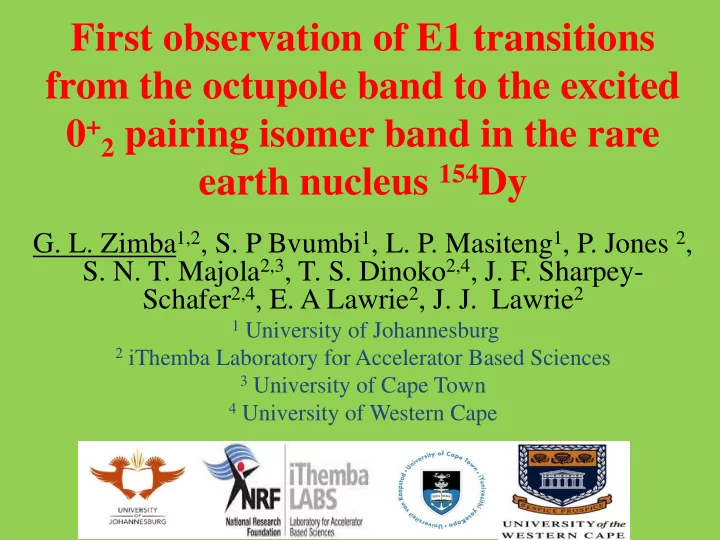

First observation of E1 transitions from the octupole band to the excited 0 + 2 pairing isomer band in the rare earth nucleus 154 Dy G. L. Zimba 1,2 , S. P Bvumbi 1 , L. P. Masiteng 1 , P. Jones 2 , S. N. T. Majola 2,3 , T. S. Dinoko 2,4 , J. F. Sharpey- Schafer 2,4 , E. A Lawrie 2 , J. J. Lawrie 2 1 University of Johannesburg 2 iThemba Laboratory for Accelerator Based Sciences 3 University of Cape Town 4 University of Western Cape
Casten R F et al. Nucl. Phys. A 439 289 1(1985 ). E(4+) E(2+) energy-ratio systematics for even-even nuclei as a function of atomic number Z. The horizontal dashed lines represent limits expected for pure vibrational (2.00), rotational (3.33), and gamma-soft (2.50) behavior, respectively .
Butler P A et al. Rev. Mod. Phys. 68 349(1996) 1 → 3 - Plot of |M(E3)| 2 , the E3 transition strength of 0 + 1 transitions for even-even nuclei, as a function of neutron number N
Octupole excitations • The octupole excitations in nuclei are related to coupling of two single particle orbitals with opposite parities and a difference of three units in the orbital and total angular momenta. • The experimental fingerprints in even-even nuclei : 1. Presence of low-lying 1 - and/or 3 - states 2. Enhanced E3 transitions (e.g 148 Nd) 3. Strong E1 transitions connecting levels of opposite parity
Separated-Sector Cyclotron Facility Separated-Sector Cyclotron Facility SSC Target vaults Spectrometer SSC Target vaults Spectrometer Polarized ion source Polarized ion source SPC2 SPC2 SPC1 SPC1 electronics electronics electronics electronics ECR ion source ECR ion source Radioisotope Radioisotope production production beam beam swinger swinger Proton therapy Proton therapy Neutron therapy Neutron therapy 0 10 20 m
Experiment • The low spin state of 154 Dy were populated using the reaction: 155 64 Gd 91 ( 3 2 He, 4n) 154 66 Dy 88 • Beam energy of : 37MeV • Target thickness: 3.2mg/cm 2
Cont: Experiment • The gamma rays emitted from the excited 154 Dy were detected by the AFRODITE spectrometer array. • Nine clover detectors were used. Four at 135 ° and five at 90 °
Gamma-gamma coincidence analysis • A symmetric matrix was constructed to deduce the decay scheme of 154 Dy • For each event, the energy of the two detected gamma-rays were stored into a two dimensional matrix. How 1. Put a gate in one transition & observed the transition in coincidence with the gating transition 2. Position the observed transition in the decay scheme.
154 Dy Total Projection
Results Odd and even gamma bands Lowest negative parity bands Partial level scheme of 154 Dy obtained from 155 64 Gd 91 ( 3 2 He, 4n) 154 66 Dy 88 reaction at 37MeV showing new transitions are shown in red.
Results Partial level scheme of 154 Dy obtained from 155 64 Gd 91 ( 3 2 He, 4n) 154 66 Dy 88 reaction at 37MeV showing new transitions are shown in red and E1 transitions from the octupole band to the band built on 0 + 2 are shown in blue.
S. P. Bvumbi Results et al. Phys. Rev. C87, 04433 (2013). 2 → 3 - 1 → 0 + 0 + 2 for 152 Gd and 150 Sm and the first observation of 3 - 2 observed in 154 Dy.
S. P. Bvumbi et al. Phys. Rev. C87, 04433 (2013). Plot of the level excitation energies against spin for the bands built on 0 + 2 for 154 Dy, 150 Sm and 152 Gd .
S. P. Bvumbi et al. Phys. Rev. C87, 04433 (2013). Plot of the level excitation energies against spin for the octupole bands for 154 Dy, 150 Sm and 152 Gd .
Conclusions • The experiment showed that 3 - 1 → 0 + 2 is present in low-lying states of 154 Dy. • As Z increases the relative excitation energies of the Octupole bands increases. This is probably the primary cause of the direction of the E1s transitions between them changing from 150 Sm and 152 Gd to the case of 154 Dy
Casten R F et al. Nucl. Phys. A 439 289 1(1985 ). • Suggest further research into N = 86 isotones Sm, Gd, Dy, Er and 156 Er E(4+) E(2+) energy-ratio systematics for even-even nuclei as a function of atomic number Z. The horizontal dashed lines represent limits expected for pure vibrational (2.00), and gamma-soft (2.50) behavior, respectively
Thank You
Energy DCO LP Transition 12 + → 10 + 985 1.17(0.1) 0.2(0.1) 7 - → 5 - 418 1.14(0.22 )* ) 8 + → 8 + 414 )* )* 5 - → 3 - 340 )* )* 7 - → 6 + 306 )* )* 5 - → 4 + 299 0.8(0.2) )* 9 - → 8 + 259 0.7(0.03) 0.19(0.09 The table on the right is showing DCO and linear polarization results, )*sign represents when we do not have enough statistics.
Recommend
More recommend